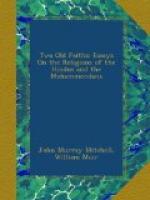[Sidenote: Connection with Persian, Greek, and Roman systems. Varuna, the god of heaven. The sublimity of the Vedic description of him.] We have first referred to Agni and Soma, as being the only divinities of highest rank which still retain their physical character. The worship paid to them was of great antiquity; for it is also prescribed in the Persian Avesta, and must have been common to the Indo-Iranian branch of the Aryan race before the Hindus entered India. But we can inferentially go still further back and speak of a deity common to the Greeks, Romans, Persians, and Hindus. This deity is Varuna, the most remarkable personality in the Veda. The name, which is etymologically connected with [Greek: Ouranos], signifies “the encompasser,” and is applied to heaven—especially the all-encompassing, extreme vault of heaven—not the nearer sky, which is the region of cloud and storm. It is in describing Varuna that the Veda rises to the greatest sublimity which it ever reaches. A mysterious presence, a mysterious power, a mysterious knowledge amounting almost to omniscience, are ascribed to Varuna. The winkings of men’s eyes are numbered by him. He upholds order, both physical and moral, throughout the universe.
[Sidenote: Contrast with the laudations of Agni and Soma. The loftier conceptions of divinity the earlier.] The winds are his breath, the sun his eye, the sky his garment. He rewards the good and punishes the wicked. Yet to the truly penitent he is merciful. It is absolutely confounding to pass from a hymn that celebrates the serene majesty and awful purity of Varuna to one filled with measureless laudations of Soma or Agni. Could conceptions of divinity so incongruous co-exist? That they could not spring up in the same mind, or even in the same age, is abundantly manifest. And, as we have mentioned, the loftier conceptions of divinity are unquestionably the earlier. It is vain to speak, as certain writers do, of religion gradually refining itself, as a muddy stream can run itself pure; Hinduism resembles the Ganges, which, when it breaks forth from its mountain cradle at Hardwar, is comparatively pellucid, but, as it rolls on, becomes more and more muddy, discolored, and unclean.[5]
[Sidenote: Indra. His achievements.] Various scholars affirm that Varuna, in more ancient pre-Vedic times, held a position still higher than the very high one which he still retains. This is probable; indeed, it is certain that, before later divinities had intruded, he held a place of unrivaled majesty. But, in the Vedas, Indra is a more conspicuous figure. He corresponds to the Jupiter Pluvius of the Romans. In north-western India, after the burning heat, the annual return of the rains was hailed with unspeakable joy; it was like life succeeding death. The clouds that floated up from the ocean were at first thin and light; ah! a hostile demon was in them, carrying off the healing waters and not permitting them to fall; but the thunder-bolt of Indra flashed; the demon was driven away howling, and the emancipated streams refreshed the thirsty earth. Varuna was not indeed dethroned, but he was obscured, by the achievements of the warlike Indra; and the supersensuous, moral conceptions that were connected with the former gradually faded from the minds of the people, and Varuna erelong became quite a subordinate figure in the Pantheon.




